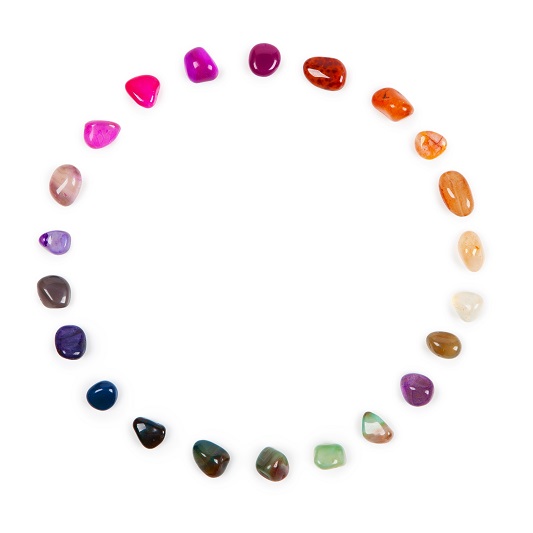Strontium Titanate

Gemstone of the Week – Ethiopian Opal
12th June 2018
Gem Silica – Gemstone of the Week
22nd June 2018First appearing in the 1950s, Strontium Titanate is a Diamond Simulant. Simply, the material has a similar appearance to Diamond but a different composition and crystal structure. The stone is generally man-made, though natural specimens are sometimes found.
When cut and polished, Strontium Titanate has a similar brilliance and lustre to Diamond. However, unlike Diamond, the material has a strong ‘Fire’. ‘Fire’ can be described as the ability to act as a prism. Materials with a strong Fire are able to separate passing light into a rainbow of colours. Though Diamond is known for its Fire, the Fire of Strontium Titanate is far superior. In this article, we explore Strontium Titanate in more detail.
How to Identify Strontium Titanate
Sometimes, differentiating Strontium Titanate from Diamond can be tricky. However, if you know what to look for the process is simple. As mentioned previously, the Fire of Strontium Titanate is much stronger than Diamond. This makes the material instantly stand out from similar gemstones. Additionally, Stronti-um Titanate often contains bubbles that reveal it’s man-made origin. With the right equipment, Strontium Titanate can be identified by its hardness. Much lower than Diamond, Strontium Titanate is quick to wear when used in gemstone jewellery – especially in pieces that are worn frequently.
Competition From Other Diamond Simulants
Once upon a time, Strontium Titanate was the Diamond simulant of choice. However, over time new ma-terials have gradually replaced it. While the appearance of Strontium Titanate is similar to Diamond, the strength of the stone is not. With a hardness of 5.5 on the Mohs scale, the material is relatively soft. Un-fortunately, the stone is easily damaged when it comes into contact with other objects. This caused the material to become less favourable for use in jewellery, and a gap in the market to open for new simu-lants.
In the 1970s, a host of new simulants began to appear. Some of the most popular varieties included GGG (Gadolinium Gallium Garnet), YAG (Yttrium Aluminium Garnet), and CZ (Cubic Zirconia). Many consumers favoured these materials because of their Diamond-like appearance and superior hardness.
In the 1990s, Synthetic Moissanite hit the shelves. The appearance of the new material was just as similar to Diamond as all of the other simulants and the hardness and fire of the stone were far stronger. This led to Synthetic Moissanite replacing many GGG, and YAG items. Cubic Zirconia, however, remained popular due to its affordability.
Today, Strontium Titanite is rarely seen in rings and bracelets; however, the material is still used for jewel-lery that encounters minimal impact such as earrings, brooches, and pendants.
Use of Strontium Titanate
Between the 1950s and 1970s, Strontium Titanate was a popular Diamond simulant. As the name ‘Stronti-um Titanite’ was hard to remember, the material was sold under a variety of trade names including ‘Fabu-lite’, ‘Diagem’, ‘Marvelite’, ‘Dynagem’, and ‘Jewelite’. The trade names were also thought to sound more appealing and less chemical-like than ‘Strontium Titanite’.
For many years, brands such as Fabulite and Diagem were popular sellers. However, customers began to realise that their jewellery was showing signs of wear. The faces of the stone started to become scratched and the facet edges were often chipped or nicked. When more durable Diamond simulants be-came available, the demand for Strontium Titanite began to decrease. Though the Fire of Strontium Titan-ite is superior to other Diamond simulants, the low durability makes it impractical for use in jewellery – especially pieces that encounter regular contact.
Today, Strontium Titanite is used in a variety of high-tech industries; notable uses include optical instru-ments, high-voltage capacitors, voltage-dependent resistors, advanced ceramics, and substrates for su-perconductors. Additionally, the stone is used for jewellery that encounters minimal abrasion such as ear-rings, pendants, and brooches. Most Strontium Titanate is manufactured by NL Industries, a company that produces a range of Titanium, Lead, and Strontium products.
Where is Strontium Titanate Found?
Originally, all Strontium Titanate on the market was man-made. It wasn’t until 1982 that naturally occur-ring specimens were discovered in Eastern Siberia and Russia. A few years later, small deposits were also found in Japan and Paraguay. Today, natural Strontium Titanate is extremely rare and is only found in small cubic crystals and irregular masses. As the specimens are so tiny, they are rarely used commercially.
Healing Properties of Strontium Titanate
Though Strontium Titanite is often man-made, the material boasts a range of healing properties – espe-cially when used as an elixir. When consumed, Strontium Titanite is believed to have similar benefits to Calcium and Magnesium. Using the material in an elixir is thought to provide strength for the skeletal sys-tem and help to create cartilage and joint capsule.
Strontium Titanite can also prevent diseases of the bones and joints. With this in mind, the mineral can be used to prevent arthritis and other joint disorders. The stone can also provide relief for those already suf-fering from the disease. When used alongside calcium, Strontium Titanite is thought to combat osteopo-rosis and improve bone density.
In Summary
Strontium Titanate is loved all over the world. While the stone is often man-made, naturally occurring Strontium Titanite can be found in Eastern Siberia, Russia, Paraguay, and Japan. Loved for its Diamond-like appearance and strong Fire, Strontium Titanate is often used in earrings, rings, and brooches. Whether you’re hoping to use the stone for its benefits within crystal healing or you’re looking for a beautiful new addition to your jewellery collection, purchase a piece of Strontium Titanate to reap the benefits.




